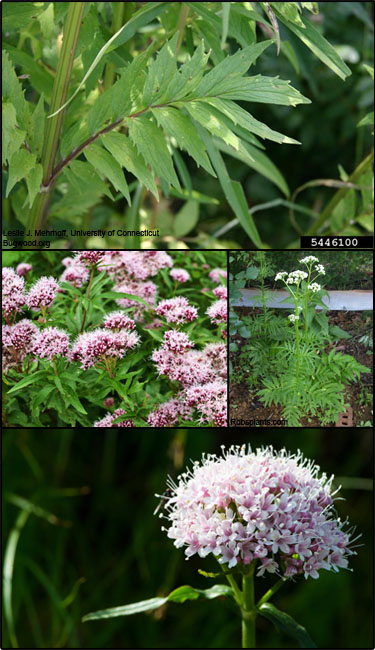Garden valerian (Valeriana officinalis)
 Common Names: Common valerian, garden heliotrope
Common Names: Common valerian, garden heliotropeDescription: Sold in nurseries and herb farms for use in gardens and herbal medicine.
Habit: Erect; herbaceous perennial; ranges from 1-4 ft in height; small rhizomes with fibrous roots.
Leaves: Pinnately compound, opposite, 11-21 leaves; toothed, lance-shaped with occasional hairs on the underside.
Stems: Stout and hairy especially at the nodes.
Flowers: Pale pink or white in color, 5 petals, funnel shaped, branched, clustered, fragrant.
Fruit and seeds: Small capsules of lance-shaped fruit produce an abundance of powdery seeds, wind dispersed and aerial stolons.
Habitat: Native to Eurasia. Found in disturbed areas, grasslands, open woods, roadsides and stream banks.
Reproduction: By seed and stolon.
Similar species: Native Valerian (Valeriana spp.) but Garden valerian has odd-pinnate leaves or deeply pinnatified leaves from top to bottom. Native valerian leaves are either undivided or less so.
Monitoring and rapid response: Monitor disturbed areas; pull or mow before flowering and can be controlled by using herbicides such as glyphosate or triclopyr. Credits: The information provided in this factsheet was gathered from the USDA PLANTS Database and the U.S. Department of Agriculture, Forest Service.
Individual species images that appear with a number in a black box are courtesy of the Bugwood.org network (http://www.invasive.org).Individual photo author credits may not be included due to the small display size of the images and subsequent difficulty of reading the provided text. All other images appear courtesy of Google (http://images.google.com).
Common Name: | Garden valerian |
Scientific Name: | Valeriana officinalis |
Family: | Valerianaceae (Valerian) |
Duration: | Perennial |
Habit: | Herbs |
USDA Symbol: | VAOF |
